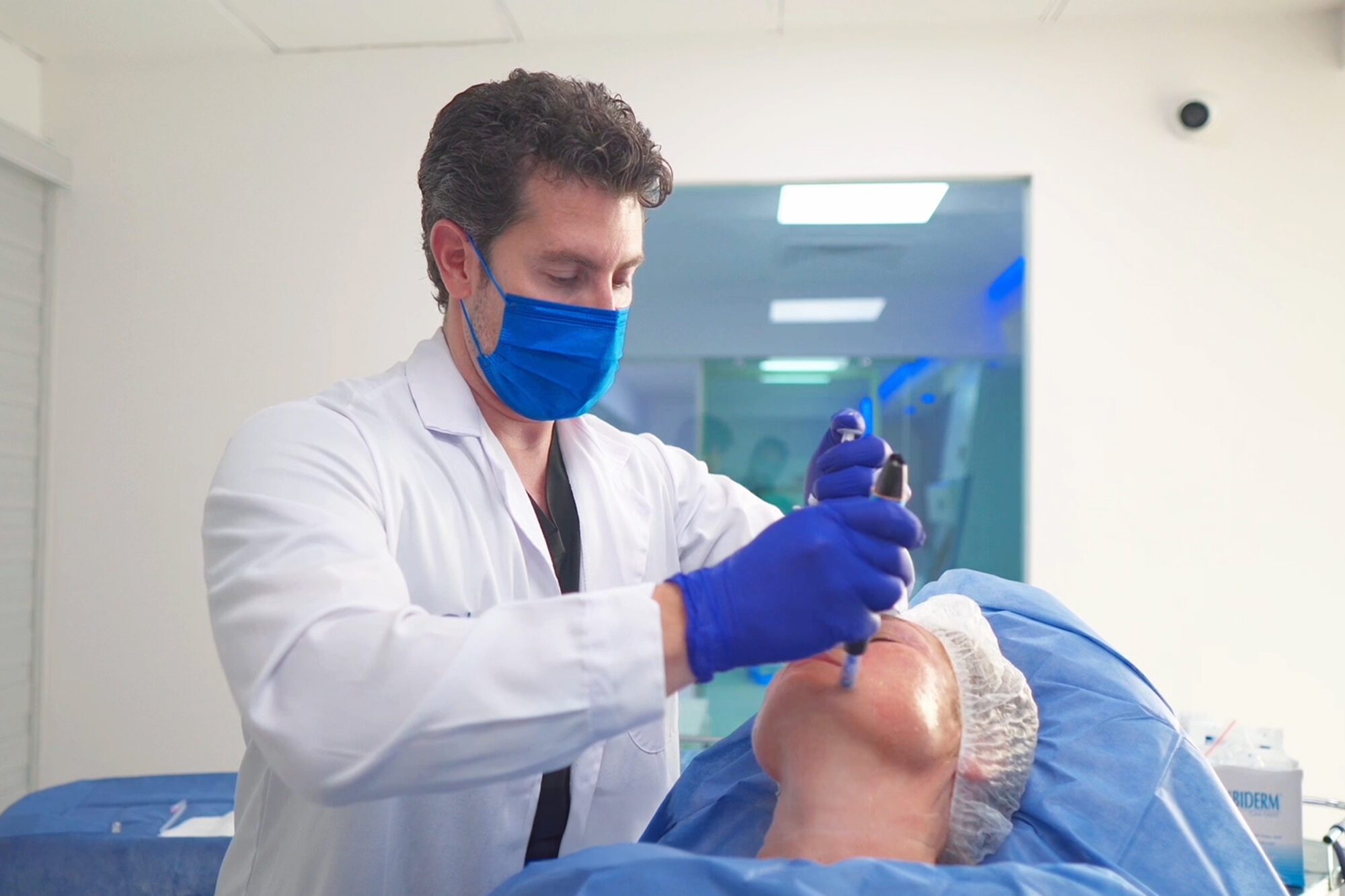Listen to the article in audio format
Is it possible for stem cells to rebuild collagen? Here are some of the most important things you need to know about stem cell therapy.
The pursuit of eternal youth has existed for centuries – from ancient elixirs and mystic rituals to modern science and biotechnology, many people have been looking for ways to defy aging and look forever young.
In our previous article, we discussed the power of stem cell therapy for age reversal, and how regenerative medicine has taken the world by storm with its unique abilities to regenerate tissue and reduce inflammation.
But is it possible for stem cells to rebuild collagen? And what does this mean in terms of anti-aging and preserving your youthful appearance? If “The Portrait of Dorian Gray” fascinates you as much as us, continue reading this article.
What is Collagen?
In order to better understand whether stem cells are able to rebuild collagen, it’s very important for us to understand what collagen actually is – and why it matters.
Put simply, collagen is what holds your body together. It is the most abundant protein in our bodies, and its main function is to provide strength, structure, and elasticity to our skin, bones, muscles, tendons and ligaments.
However, as we age, our bodies naturally start to produce less collagen as a result of slower cell function. Since this protein is what “holds the body together”, lowered collagen production leads to wrinkles, sagging skin, and joint pain.
You might say: “This all sounds great – but what do stem cells have to do with collagen?” We are glad you asked – let’s take a look:
Can Stem Cells Rebuild Collagen?
So, can stem cells rebuild collagen? The short answer is yes – stem cells stimulate the natural repair process of your body, transforming into collagen-producing cells like fibroblasts.
In addition, they release growth factors that can signal your skin to make more collagen on its own. Essentially, what makes stem cell therapy unique compared to conventional treatments is that it doesn’t only patch things up.
Instead, they practically reboot your system, encouraging stronger, healthier, and more youthful skin from the inside out.
How Do Stem Cells Rebuild Collagen?
We just gave you a short answer on how stem cells rebuild collagen – but let’s get into the detail of how the process actually works:
Step 1: Collection & Preparation of Stem Cells
In order to activate the process of rebuilding collagen, first we need to collect and process the stem cells which will be used for the anti-aging treatment.
At Cellular Hope Institute, we work with allogeneic stem cells (aka stem cells collected from donors), which have been carefully screened, purified, and expanded in regulated lab conditions to ensure their safety, potency, and consistency.
At the next step, we will inject these stem cells into the area that you are looking to rejuvenate, successfully initiating the anti-aging process.
Step 2: Migration To The Injury Site
When it comes to stem cells rebuilding collagen, there is one important thing that we will need to keep in mind.
When tissue is injured or aging begins to degrade collagen, chemical signals like cytokines, growth factors (e.g., TGF-β, PDGF, FGF), and inflammatory markers are released.
Our stem cell treatment will respond to these biological signals by migrating the stem cells to the affected area, releasing regenerative factors, and activating local fibroblasts to produce new collagen.
This not only supports natural tissue repair but also enhances collagen density and structural integrity, leading to firmer, healthier skin or improved joint and tissue function – depending on the application.
Step 3: Differentiation Into Fibroblasts
Speaking of fibroblasts, we can’t forget to mention this key step of how stem cells rebuild collagen. Once the stem cells are injected in the damaged area, they receive local microenvironmental signals that induce them to differentiate into fibroblasts.
Fibroblasts are the specialized cells responsible for synthesizing and remodeling collagen and other components of the extracellular matrix (ECM).
Put simply, what all of this means for you is that stem cell therapy doesn’t just stimulate temporary improvement – it actively supports deep, long-lasting regeneration of your skin or tissue by successfully rebuilding collagen.
Step 4: Collagen Production & Repair
Once the stem cells turn into fibroblasts, these cells get to work making new collagen – specifically collagen types I and III, which are the building blocks of healthy skin, joints, and connective tissue.
The fibroblasts produce and release collagen into the damaged area, where it starts to form strong fibers that support and repair the tissue. But it’s not just about stem cells rebuilding collagen – it’s also about organizing it correctly.
Your body naturally arranges these new fibers in the right direction to strengthen and rebuild the area. At the same time, the body breaks down old or damaged collagen and replaces it with fresh, well-structured collagen — like clearing out broken bricks before building a stronger wall.
The result? Healthier, firmer, and more resilient tissue so you can enjoy a more youthful skin!
What Are The Benefits of Anti-Aging Treatments With Stem Cells?
Did you know that stem cells rebuilding collagen isn’t the only benefit that you can enjoy from your anti-aging stem cell treatment? Yes, there are many benefits from getting an anti-aging therapy with stem cells – here are just a few of them:
- Cellular Regeneration – As we mentioned earlier, stem cells don’t only focus on patching things up – they can actually replace or repair damaged cells, rejuvenating the skin at a deeper level than topical products.
- Stimulate Collagen & Elastin – Stem cells rebuild collagen and stimulate the production of elastic. Both proteins are responsible for skin strength, elasticity, and firmness, which reduces fine lines and wrinkles while tightening sagging skin.
- Decrease Inflammation – Another amazing benefit of stem cell anti-aging treatments is that they reduce chronic inflammation (which tends to accelerate aging). They also release anti-inflammatory and antioxidant molecules to protect from further damage.
- Improve Skin Hydration – In addition to all of the above-mentioned benefits, stem cells also improve skin hydration by supporting the extracellular matrix. This restores your natural glow and enhances your overall complexion.
- Minimally Invasive – As opposed to other procedures, anti-aging treatments with stem cells are minimally invasive, with little to no side effects. And the best part? The results are long-term as stem cells target the root cause of aging!
As you can see, in addition to stem cells rebuilding collagen, you can enjoy a wide variety of benefits that can positively impact your overall well-being.
In some cases, they may even extend their benefits further, from improving joint function and mobility to increasing energy levels and vitality.
What Is The Best Stem Cell Treatment For Anti-Aging?
Now that you know that stem cells rebuild collagen, you may be wondering – what is the best stem cell treatment for anti-aging?
At Cellular Hope Institute, we recommend using allogeneic mesenchymal stem cells for stem cell anti-aging treatments. That’s because they are younger, more potent, and immediately available – without the need for invasive harvesting from the patient.
These stem cells are sourced from carefully screened, healthy donors and are rich in regenerative factors that help stimulate collagen production, reduce inflammation, and promote tissue repair at a cellular level.
This allows us to deliver consistent, high-quality results that support smoother, firmer, and more youthful-looking skin from the inside out.
Which Is The Best Stem Cell Clinic for Stem Cell Therapy For Anti-Aging?
The best stem cell clinic for anti-aging stem cell therapy is Cellular Hope Institute, located in Cancun, México. We are known for our innovative facilities, advanced regenerative therapies, and a team of highly experienced physicians.
If you are looking to rejuvenate your body and mind while significantly improving your quality of life, look no further than Cellular Hope Institute. We will accompany you at every step of the process – from picking you up at the airport to ensuring top-notch post-treatment care.
Are you ready to get started? Schedule a consultation today.
FAQ
Can stem cells reduce aging?
Yes, stem cells can help reduce visible signs of aging by promoting natural regeneration at the cellular level. They stimulate collagen and elastin production, repair damaged tissues, reduce inflammation, and improve skin hydration.
This leads to firmer, smoother, and more youthful-looking skin while supporting overall tissue health from the inside out.
Do stem cells provide natural results for anti-aging?
Yes, stem cells provide natural results for anti-aging by working with the body’s own repair mechanisms. Instead of simply masking signs of aging, they regenerate and restore skin from within – stimulating collagen, improving elasticity, and enhancing overall skin tone and texture for subtle, long-lasting, and naturally youthful outcomes.
How much does stem cell anti-aging therapy cost?
The cost of stem cell anti-aging therapy can vary widely depending on the clinic, treatment area, number of sessions, and type of stem cells used. On average, prices range from $3,000 to $15,000.
While it’s a higher upfront investment, many patients choose it for its long-lasting, regenerative benefits compared to traditional cosmetic treatments.
What is the cheapest country for stem cell therapy?
Mexico is one of the cheapest countries for stem cell therapy, offering significantly lower costs compared to the U.S.
While similar treatments in the U.S. can range from $10,000 to $25,000, clinics in Mexico often provide high-quality stem cell therapy for a fraction of the price, making it a popular destination for affordable regenerative care.
How long do stem cell injections last?
The effects of stem cell injections can last anywhere from 6 months to several years, depending on the individual, the condition treated, and the type of stem cells used.
For anti-aging treatments, many patients notice long-lasting improvements in skin texture and firmness, with results that often outlast traditional cosmetic procedures. Maintenance treatments may enhance longevity.

